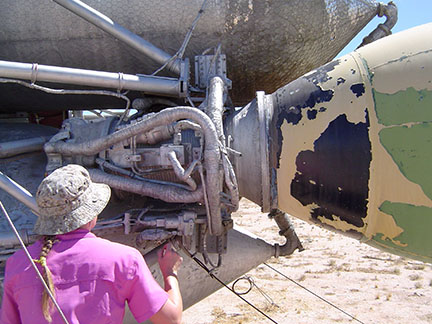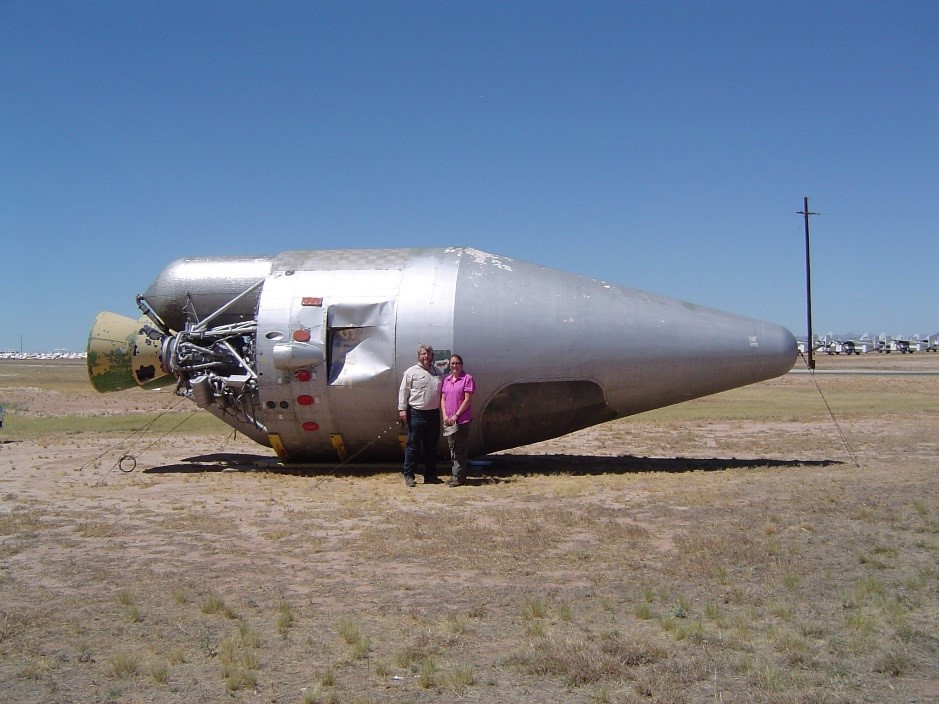Update: Orbital Debris Program Office to Procure Titan Transtage for Research
Updated 6/7/16: For an update on the arrival of the transtage, read "Titan Transtage arrives at Johnson to be studied by orbital debris scientists" by Johnson Space Center.
NASA’s Orbital Debris Program Office (ODPO) is acquiring a Titan Transtage from the Aerospace Maintenance and Regeneration Group (AMARG), commonly known as “the Boneyard,” at Davis-Monthan Air Force Base in Tucson, Arizona, to conduct spectrographic inspections to better understand these historic spacecraft.
The Transtage, an upper stage of the Titan III rocket family, was developed in the 60s to lift heavy payloads or multiple small payloads to specific locations in Low-Earth Orbit and Geosynchronous Earth Orbit (GEO). There have been three observed breakups in GEO, and two of them involved Titan Transtages (a third Transtage fragmented in GEO Transfer Orbit), which raises the question, what’s causing this? Are collisions causing the Transtages to explode, or did residual propellants inadvertently mix and explode? Did the fuel and oxidizer mix as the result of a leaky valve or did pressure vessels used to push the fuel and oxidizer around get breached and explode? The mystery deepens as telescopic observations of GEO, coupled with computer modeling, indicates more debris to be present than can be accounted for with the known breakups.
“We just don’t know,” said Dr. Phillip Anz-Meador, the ODPO’s support contractor program manager with Jacob’s Technology, Inc. “It’s sort of a CSI of GEO, if you will, in that we’re trying to understand more about the environment and the causes of these events. One goal of getting this thing is to have a real, live specimen that we can have in the lab.”
Anz-Meador, among others, was under the impression that all existing Titan Transtages were in orbit. So when he came across a picture of one online at AMARG, he and the rest of NASA’s Orbital Debris team were excited for the potential to study it up close. Anz-Meador and Jacob’s Technology Optical Lead Dr. Heather Cowardin went to the base to evaluate the Transtage and confirmed it wasn’t simply a model or replica. Although used for test, display and demonstration purposes in the past, the basic structure, engines and fuel tank of the Boneyard Transtage are as flown.
GEO is prime real estate in terms of space locations, so the program office and the international space community want to understand and mitigate orbital debris in this area. However, because GEO is farther from Earth, it can be difficult to see small pieces of debris and there are limited resources devoted to tracking payloads and debris in the area.

Cowardin inspects the Transtage’s Aerojet engine assembly.
Photo credit: Anz-Meador and Cowardin
The soon-to-be-acquired Transtage will provide ODPO with
- Information for the office’s spectral database to help interpret telescope measurements
- Data to incorporate into computer models of the space environment
- Information to complete forensics to understand why things break up in space
Cowardin and her team use a telescope to take spectral measurements of orbital debris pieces in GEO to determine the piece’s location, orbit, size and origin (what it is). Specifically, they use a spectrometer to identify absorption features — that is, how the light reflects from the material.
“It’s just like a fingerprint — it’s unique to that material,” explained Anz-Meador.
Using this method to determine the color of the orbital debris, Cowardin can conclude what part of the Transtage (or other payload) they saw in the telescope and therefore what material it likely is. Having a Transtage available for comparison enhances the teams’ ability to make these conclusions, and as a result, hypothesize what may have happened.
“It’s of interest to us both in GEO and Low-Earth Orbit because the size and material directly affect the damage these things can cause,” said Anz-Meador.
For example, a piece of plastic would cause less damage if it hit the International Space Station than a same-size piece of stainless steel.
“We’re trying to develop a decoder ring, so to speak, between Heather’s optical measurements and the size and material,” said Anz-Meador.
ODPO is working with its sister office, the Hypervelocity Impact Technology group, on incorporating refined densities into damage equations via probabilistic density distributions.
“The work we’re doing is to help better understand various densities and how the shape can affect [it],” explained Cowardin.

Anz-Meador and Cowardin demonstrate the Transtage’s scale at AMARG, Davis-Monthan Air Force Base.
Photo credit: Anz-Meador and Cowardin
According to Cowardin, the “it” refers to the damage assessment equation used to assess a particle’s size after an impact.
“That’s part of the forensics we are trying to study,” she continued.
The team also hopes to scan the Transtage and print a small, 3-D replica to simulate telescope observations. It can be difficult to tell from observations whether a Transtage truly is damaged because it’s an asymmetrical vehicle. Cowardin and her team can position the 3-D model to match the real one in space and compare a pristine, undamaged Transtage in the same position as the one being observed. Factoring in everything from the sun’s position to the exact location of the Transtage to where the observer is located allows the team to make accurate determinations as to what damage would look like.
The information from these studies will factor into ODPO’s evaluation of the environment, as well as models of damage, how things breaks up when they explode and how dangerous a given piece of debris is to other, active satellites. These models can then influence future spacecraft designs and features.
Anz-Meador considers this project a home run in terms of the office’s goals: measure, model, mitigate.
“It really achieves all our office goals and mission statement,” he said. “One of the things unique about our office is we have to keep track of things all the way back to the dawn of the space age…things launched in the 60s, this year, in two years.”
After the completion of ODPO studies, the Titan Transtage may have a second life in Johnson Space Center’s Engineering Directorate as a part of Active Debris Removal (ADR) studies, which explore ways to remove orbital debris from space. It would provide a realistic example of a massive, complex target object. In the future, ADR studies may mature into technologies that could remediate the debris environment by removing old, derelict objects from orbit before they collide with another body.
NASA and the Transtage
The Titan Transtage was a robust, powerful and advanced piece of technology that allowed mission planners to carefully place payloads in space.
Although the Department of Defense and other government agencies were the primary users of the Transtage, NASA did launch one payload with it that turned out to be historically significant — the Applications Technology Satellite-6, commonly referred to as ATS-6. The satellite achieved many space communications firsts, such as the first satellite-to-satellite communication experiments and the first course taught by satellite television. It also enabled live TV coverage of the Apollo-Soyuz Test Project rendezvous, in addition to many design firsts including being the first three-axis stabilized communications satellite and the first spacecraft to use a digital computer for attitude control, solid stage high-power Radio Frequency transmitters, graphite composites in its primary structure and heat pipes for thermal control, together forming the largest geosynchronous communications satellite to date, at that time.
“It was a neat example of a ground-breaking payload in the 1960s,” said Anz-Meador. “It pioneered a lot of techniques used by geosynchronous satellites.”